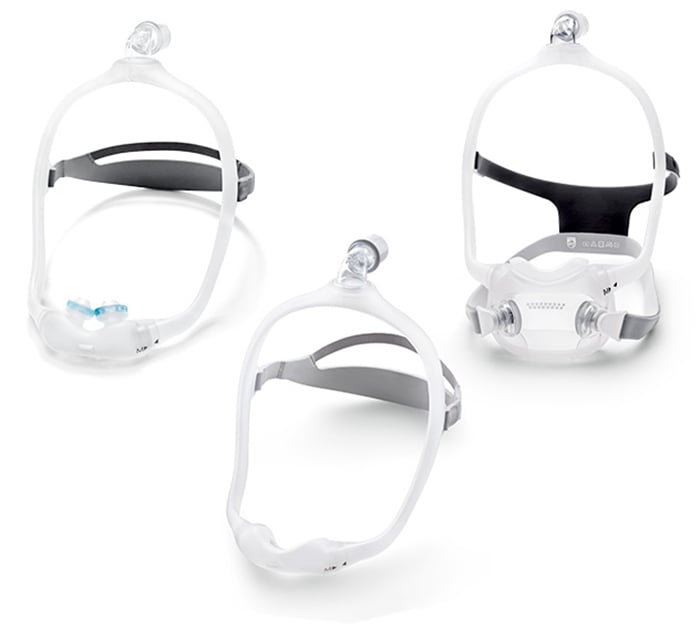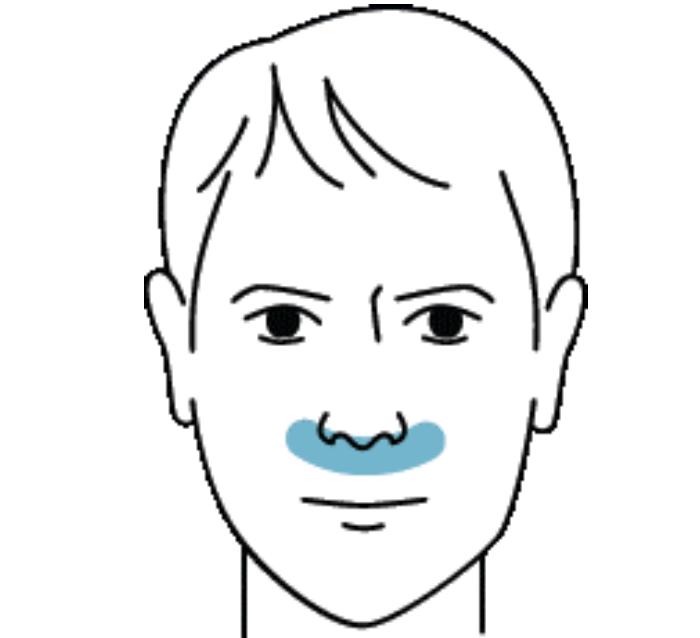Ditch the hose nose and sleep in any position you want
Get the rest you deserve with DreamWear – a radical departure from traditional mask technology. The versatile system is designed for exceptional fit and comfort, and makes it easy to swap cushions, so you can find the perfect match..

DreamWear comes closest to making users feel like they have nothing on their face during therapy.1-3 DreamWear users state they didn't need to choose a sleep position when wearing DreamWear.1-3 Users felt they experienced more freedom of movement with the DreamWear versus their prescribed mask.1-3 DreamWear's innovative design prevents red marks, discomfort and irritation on the nose bridge.4

Myth: One mask fits all.

Fact: Everyone’s face is unique. It’s important to find the mask that fits and works for you.
By Teofilo Lee-Chiong, MD, chief medical liaison, Philips Healthcare Solutions
Explore your choices
Philips offers a comprehensive portfolio of state-of-the-art sleep apnea masks that combine performance and comfort. View all Philips sleep apnea masks

Full face masks Full face masks let you breathe with your mouth open while you sleep.

Nasal pillow masks Nasal pillow masks provide a seal around each nostril with minimum contact to the face.

Nasal cradle masks Nasal cradle masks eliminate contact with the bridge of your nose.

On the nose nasal mask Nasal masks are ideal if you breathe through your nose while you sleep.
See instructions for use for each individual mask
After putting DreamWear on the first time, I just loved it. There was a lot more freedom of movement with it… ”
-John H., who has sleep apnea
DreamWear mask parts and accessories
Several mask options work with a single, flexible, over-the-head frame.

DreamWear Full Face Cushion

DreamWear Gel Pillow Cushion

DreamWear Nasal Cushion

DreamWear Frame
Comfort and fitting tips
A mask that fits properly is crucial to keeping you committed and comfortable. Here are some tips to follow:

Use the smallest size mask that fits without pinching.

A tight fit is not necessary. Try loosening the mask if there are leaks.

Headgear should be secure but not too tight. If your mask has a forehead arm or adjustment feature, adjust that first. Adjust straps to minimize air leaks.

The cushion should not be crushed against your face.

Don’t block the exhalation port between the mask and the connecting tubing. Position the port away from your bed partner.

The mask should be fitted while you are in a sleeping position and with air blowing at the prescribed pressure.

Mark the headgear straps with permanent marker to remember where they should be fastened.

Remove the mask by pulling it over your head or use the quick-release clip.

Consider looping the tubing over the headboard to reduce the pull on the mask.

If your mask was fitted with your dentures in, your mask may not fit properly without them.
Frequently asked questions
- What does a mask do?
-
Masks are used to deliver the air from the therapy device to you. A comfortable mask is a key factor in being able to use your treatment daily, so finding a mask that fits you and your lifestyle is important. Most masks have built-in exhalation ports that vent your exhaled air. Talk to your homecare provider about the different masks and headgear available.
- What does a chin strap do?
-
Chin straps are optional accessories that can be used with a variety of nasal and nasal pillows masks. They wrap around the top of your head and underneath your chin to keep your mouth from opening at night.
- My eyes are sore, dry, irritated or swollen. What should I do?
-
The mask may be leaking into your eyes. Try pulling the mask away from your face and repositioning it. The mask may be too tight so try readjusting your headgear straps.
- My skin seems to be irritated. What should I do?
-
Your mask may be too tight. If your mask has a forehead arm or adjustment feature, try readjusting that first. Then, if necessary, readjust the headgear straps. You may have the wrong mask size. Ask your homecare provider for a mask fitting. Nasal pillows or a full-face mask may provide a better fit.
- What should I do about a dry nose and throat, congestion or nosebleeds?
-
This may improve over time. Ask your doctor for a prescription for humidification and if a nasal spray would be a good idea. Talk with your doctor if the condition persists.
- My mouth is dry. What should I do?
-
You may be sleeping with your mouth open. Try a chin strap. If a chin strap is not helpful, a full-face mask may be considered or you should consult with your doctor about adding heated humidification.
- What should I do if I feel gassy and bloated in the morning?
-
Try sleeping with your head raised or try using a chin strap to prevent mouth breathing. This condition may improve over time.
- My mask seems to be leaking. What should I do?
-
Check all the connections. If your mask has a forehead arm or adjustment feature, try readjusting that first to correct the leak. If there is no improvement with the above steps, readjust the headgear straps. The mask should be as loose as possible while still creating a seal. A mask that is too tight against the face can cause leaks by creating folds in the material. Talk to your homecare provider about trying another mask size or type if necessary.
- When should I replace my sleep therapy components?
-
Replacing your equipment before it gets worn out is an important part of your sleep therapy routine.
Signs that you should replace your mask or mask parts
- It has leaks caused by seal deterioration in the mask
-
Facial oils deteriorate the sealing effect of cushions over time, even with proper hygiene. Don't tighten the headgear when you feel leaks. Over-tightening causes discomfort and pressure points and can lead to additional leaks.
- Your mask doesn’t fit properly
-
A mask that doesn’t fit can cause you to readjust your mask continually and/or over-tighten the headgear, which reduces how long it can work effectively. Contact your provider to get re-fitted.
- It’s damaged by improper cleaning
-
Use only mild, soapy water. Don’t use soaps with moisturizers or perfumes.
- It has signs of aging or damage
-
These can be leakage issues, cushions that lose shape and/or components or cushions that become cracked or torn.
- Will my insurance cover new components?
-
The table below shows how often Medicare will cover replacement parts. Please check with your healthcare insurance provider about what they allow. If a component appears to be worn out, you may want to consider replacing it even if it’s not covered by your insurance. Worn out components can reduce the effectiveness of your sleep therapy.
- How do I clean my equipment?
-
It’s important to clean your equipment as specified in your product instructions. Poor maintenance can make your sleep therapy ineffective and damage your equipment.
Important! Never use any type of alcohol or cleaning solutions on your mask, nasal pillows or tubes. It can damage them. Use only warm, soapy water.
Daily cleaning
- Mask: Remove the mask/nasal pillows from the headgear. Clean with warm, soapy water. Rinse. Air dry.
- Tubing: Wash in warm soapy water, then rinse and air dry.
- Humidifier:
1. Empty the humidifier and let it air dry.
2. Change the water in the humidifier.
3. Always use distilled water in the humidifier to avoid mineral deposit build-up.
Weekly cleaning
- Filter: Clean the gray/black foam filter in your machine with warm soapy water. Rinse. Allow to dry. Reinstall.
- Headgear: Wash headgear by hand with warm, soapy water. Rinse and let air dry.
- Machine: Wipe the machine with a soft, damp cloth.
- Humidifier: Clean the humidifier chamber with white vinegar to prevent mold growth. Be sure to rinse thoroughly with distilled or sterile water before using the humidifier.
Monthly cleaning
Filter: Replace the white disposable filter (if applicable).
- How do I know when I should replace my mask?
-
Replacing your equipment is an important part of being successful with your sleep therapy. There are several things you need to watch for related to replacing your mask:
- Seal deterioration in the mask
- An improperly fitting mask
- A mask damaged by improper cleaning
Check with your homecare provider regarding replacement options through your insurance policy.
- What cleaners should I not use when cleaning my mask?
-
Avoid soap with conditioners or moisturizers. Do not use bleach, alcohol or cleaning solutions with alcohol.
- What should I do if my mask is causing skin irritation?
-
Your mask may be too tight. If your mask has a forehead arm or adjustment feature, try changing that first. Then, if necessary, readjust the headgear straps. Tightening of your headgear too much may cause unnecessary discomfort and leaks. Remember, not all leaks have to be corrected, so your mask does not have to be completely air-tight.
- What if I feel claustrophobic when wearing my mask?
-
Try wearing your mask around your home during the evening as you go about your normal activities. This may help you get more comfortable with the mask. If you continue to feel claustrophobic, your respiratory therapist can help you to find a mask that is more comfortable for you.
- What should I do if my mask pulls my mustache or beard?
-
- What do I do if my nostrils hurt after using therapy?
-
- What do I do if I have marks or irritation after using my mask?
-
- What if I accidentally removed my mask while sleeping?
-
- How can using a humidifier help with nasal congestion?
-
- What if I feel gassy or bloated after using CPAP therapy?
-
- How do I fix marks or irritation on my top lip?
-
- How do I fix strap marks on my face after using therapy?
-

Looking for product information?

Are you a sleep professional?
References For informational purposes only, not to replace physician's directions.




